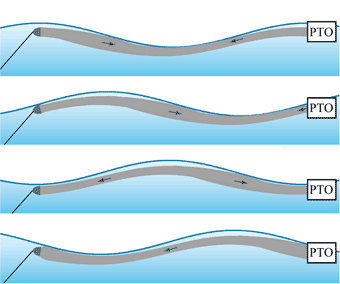The surge of renewable energy technologies has ushered in a new era of innovation, where human ingenuity seeks to harness the formidable powers of nature. Among these avant-garde inventions, the wave-powered Anaconda stands as a testament to the potential lurking beneath the ocean’s surface. The Anaconda Wave Energy Converter (WEC) concept embodies not just an engineering marvel but a symbiotic relationship with the very forces that shape our planet’s maritime ecosystems.
At first glance, the Anaconda presents an arresting image, reminiscent of a sinuous serpent undulating with the rhythm of the sea. This visual metaphor is not merely aesthetic; it reflects the design’s essential functionality. The serpentine structure allows it to adapt to varying wave patterns, capturing energy from the omnipresent ocean swells with an efficiency that static counterparts can scarcely match. Just as an anaconda coils around its prey, this technology envelops the energy of the waves, employing cutting-edge hydrodynamics to optimize performance.
Furthermore, the Anaconda’s design is not only born of aesthetic consideration but also of ecological sensibility. One of the most remarkable aspects of this device is its capacity to coexist harmoniously with marine life. Unlike traditional offshore wind turbines that disrupt avian migrations or undersea drilling platforms that ravage habitats, the Anaconda operates well within the confines of the reproductive cycles and nesting grounds of various aquatic species. This striking adaptability enhances its appeal in an era increasingly defined by environmental consciousness.
The operational principles behind the Anaconda are rooted in well-established physical phenomena. Ocean waves represent enormous kinetic and potential energy reservoirs, driven by gravitational forces and the wind’s capricious touch. The Anaconda employs a system of floats and tendons, reminiscent of the natural buoyancy found in much of marine flora and fauna, which catch the upsurge of each wave. Through a series of hydrostatic drives and actuators, mechanical energy is transformed into electrical power. The resulting energy output is not just a fraction of what the ocean has to offer; it represents a profundity of potential that is pivotal for sustainable progress.
Specifically, the Anaconda’s design enables it to harness energy across a spectrum of wave conditions. This versatility distinguishes it from traditional point-absorber WECs that often require specific wave characteristics for optimal operation. By seamlessly adapting to the dynamic nature of the ocean, the Anaconda ensures a steadier flow of energy production, mitigating the challenges often associated with variable energy sources. With the incessant motion of the tides and currents, the Anaconda could contribute substantially to a more resilient electrical grid.
Yet, the Anaconda is not merely a tool; it represents a paradigm shift in our interaction with nature. By embracing marine energy, society stands on the precipice of a new relationship with the oceans—one marked by reverence and responsibility. The ocean, previously deemed a mere resource, transforms into a partner in the pursuit of energy sustainability. This symbiosis can help mitigate the anthropogenic impacts of climate change, fostering both ecological well-being and energy independence.
However, the Anaconda must navigate a labyrinth of challenges on its journey toward implementation. The initial capital expenditures for development and deployment can be formidable, often dwarfed by the vast financial ecosystems supporting fossil fuels. Furthermore, scaling the technology to a level that allows for significant grid impact is fraught with complexities, ranging from unforeseen maintenance issues to the construction of necessary infrastructure.
Policy frameworks and regulatory environments can also pose significant hurdles. The integration of enormous floating structures into marine territories often necessitates extensive environmental impact assessments and discussions among stakeholder groups, including fishing communities and environmental activists. Understanding the balance between energy needs and ecological stewardship symbolizes a crucial dialogue for the Anaconda’s future.
In contrast, the promise of the Anaconda extends beyond mere aesthetic and functional appeal; it embodies a narrative of resilience and sustainability. Consider a future in which entire cities are powered by the ebb and flow of the ocean, a harmonious exchange between humanity and the seas. The Anaconda serves as a beacon of hope—a conceptual vessel that transforms turbulent waves into a steady stream of clean energy, much like metamorphosis, changing stormy seas into serene power.
The Anaconda Wave Energy Converter capacities demonstrate the ocean’s untapped abundance, calling for further exploration and investment. Tapping into this immense potential poses a striking illustration of how technological advancement can occur hand-in-hand with ecological preservation. As research and development continue to refine the Anaconda’s design and operational efficiency, we stand on the brink of an energy renaissance—one that promises to redefine humanity’s forays into the limitless blue.
The ocean is no longer viewed merely as a vast expanse of watery wilderness; it emerges as a cradle of renewable energy possibilities. The Anaconda symbolizes this shift, an emblem of what can be achieved when innovation meets inspiration, prospecting energy ‘gold’ amid the relentless waves. In this grand narrative of change, the ocean is poised to become humanity’s most powerful ally in forging a sustainable future, and the Anaconda is set to lead the charge— a formidable energy beast ready to coil around the uncertainties of our energy crises.












